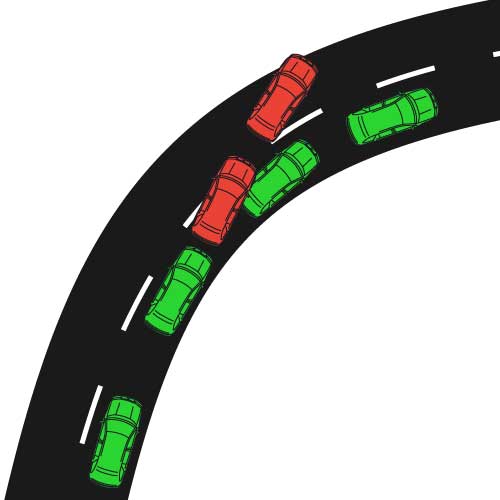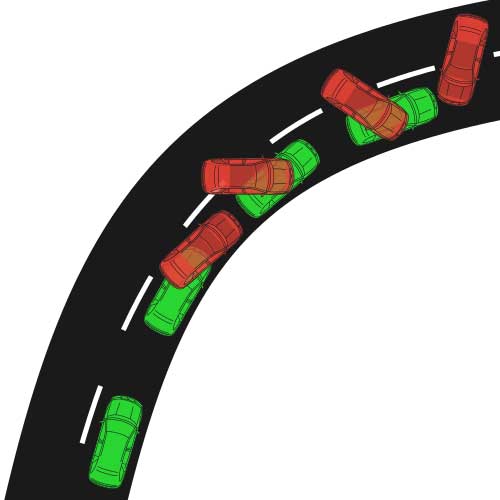Contents
What is understeering and oversteering?
To change the trajectory during the movement, the cars use the steering mechanism. It is possible to change the direction of the car direction by steering the wheels. This operation is performed by changing the steering wheel plane relative to the longitudinal plane of the car.
Changing the car direction is possible due to the adhesion between the tires and the driveway. During a turn, part of the friction force between the steering wheels is used to change direction, the rest being used for braking or accelerating the car.
For a certain steering angle, the car has a certain turning radius. If the car that is in a turn is moving within the radius of the steering angle, the steering is neutral. If the actual radius of the car is larger than the normal radius (corresponding to the steering angle of the steering wheels) then the car will understeer. Otherwise, if the actual turning radius is smaller than the normal radius, then the car will oversteer.
Unfortunately, road education is not to everyone’s liking. Very few drivers get to take a defensive driving course that will explain and show them how road safety is working. Or learn what understeering or oversteering means.
Depending on the position of the engine in a car, the type of traction, the road surface, tires, speed, brakes, and many other factors, a car can behave in several ways in a turn. Ideally, the car will keep its course and stay in a default direction set by the driver, but there are cases when something more special happens: either understeer or oversteer.
Understeering means, the behavior of a car in a turn under the central direction of the turn. Thus, the car steers less than it should for different reasons, failing to hold the steering axle, but heading in the opposite direction of the turn. And this is manifested by keeping a forward direction, even if the turn is to the left or right.
Oversteering means, as the name implies, the behavior of a car in a curve over the central direction of the turn. Thus, the car is turning more than it should for various reasons, failing to hold the steering axle, heading in the direction of the turn but far too much, leaving the trajectory. This is manifested by “spinning” the car.
To better understand, understeering means when you pull the steering wheel left or right, but the car goes forward or does not turn. And oversteering means when you pull the steering wheel, and the car spins or car rear keeps moving forward.
When does understeering occur?
There are several types of understeer. It can be understeer on acceleration or understeer on braking, for example. Understeer on acceleration generally occurs in cars with front-wheel drive, because they have the weight on the front and the front wheels, which are those with traction, can not counteract inertia. On the other hand, in the rear-wheel-drive cars, the understeer can be canceled, accelerating the rear of the car in the opposite direction.

When does oversteering occur?
Oversteering occurs in rear-wheel-drive or all-wheel-drive cars, cars that have engines in a central position or special traffic situations. Rear-wheel-drive cars are known to everyone as cars that oversteer on acceleration because when accelerating in turns, the rear tends to go forward. If the power is too high and the speed is chosen incorrectly, we risk spinning. That’s how drifting was born because is based on the phenomenon of oversteering.
Cars with front-wheel-drive cannot oversteer on acceleration, because of the car’s weight, but also the traction pulled in the same direction. But a rear-wheel-drive car, even if it has the engine in front, can push the rear forward counteracting the understeer, thus oversteering.

Which is more dangerous: understeer or oversteer?
When you understeer and lose control of the car, there are certain risks. For example, in a right turn, you can enter the opposite direction or in the parapet. And if it is a left turn, you can hit a tree, go in a ditch or a pole on the roadside. When you oversteer and the car tends to spin, the opposite things are happening. In conclusion, neither option is good, both are equally dangerous.
How do we cancel the effects of understeer?
If we feel in a turn that the car is understeering and we lose control, we must immediately get our foot off the acceleration pedal. We do not have to brake aggressively and suddenly, but only to reduce speed and maintain a grip on the road, so that we return to the optimal track. Only with a speed adapted to the road conditions, we can avoid understeer.
How do we cancel the effects of oversteer?
Besides the fact that it is not ideal to get in such situations on public roads, always maintaining a legal speed and adapted to weather and road conditions, if we face such a situation, it is good to know a few details. When we feel that the car wants to spin, we must immediately take the foot off the acceleration pedal and pull the steering wheel in the opposite direction. It is ideal to follow the courses of a defensive driving school that teaches us what to do in such situations because otherwise, the driver tends to brake suddenly, which is not good.
So, to avoid the occurrence of oversteer, the travel speed during a turn must be as low as possible and sudden and intense braking avoided. Experienced drivers can also apply a measure of survival correction, called countersteering. This is achieved by reversing the steering wheels with the acceleration of the car. In this mode, the car is rotated around the vertical axis, the skid of the rear axle being controlled.
In general, current active safety systems, such as ESP, TA, ABS or ASR, do not let you lose control of the car. So, you need to have great speed, the road to be very slippery and the driver’s driving style to be violent, for the car to go into oversteer or understeer. If these electronic systems do not protect us and we believe we are great “pilots”, at least we can learn from real pros what to do in such situations. You don’t know when it can save your life.